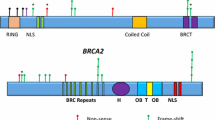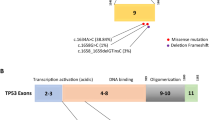Abstract
Premenopausal breast cancer (BC) is one of the most common cancers of women in rural Africa and part of the disease load may be related to hereditary predisposition, including mutations in the BRCA1 gene. However, the BRCA1 mutations associated with BC in Africa are scarcely characterized. We report here 33 BRCA1 point mutations, among which 2 novel missense variants, found in 59 Central Sudanese premenopausal BC patients. The high fractions of mutations with intercontinental and uniquely African distribution (17/33, 51.5 % and 14/33, 42.4 %, respectively) are in agreement with the high genetic diversity expected in an African population. Overall 24/33 variants (72.7 %) resulted neutral; 8/33 of unknown significance (24.3 %, including the 2 novel missense mutations); 1 (3.0 %) overtly deleterious. Notably, in silico studies predict that the novel C-terminal missense variant c.5090G>A (p.Cys1697Tyr) affects phosphopeptide recognition by the BRCA1 BRCT1 domain and may have a pathogenic impact. Genetic variation and frequency of unique or rare mutations of uncertain clinical relevance pose significant challenges to BRCA1 testing in Sudan, as it might happen in other low-resource rural African contexts.


Similar content being viewed by others
References
Pagani F, Baralle FE (2004) Genomic variants in exons and introns: identifying the splicing spoilers. Nat Rev Genet 5(5):389–396
Plon SE, Eccles DM, Easton D et al (2008) Sequence variant classification and reporting: recommendations for improving the interpretation of cancer susceptibility genetic test results. Hum Mutat 29(11):1282–1291
Lee MS, Green R, Marsillac SM et al (2010) Comprehensive analysis of missense variations in the BRCT domain of BRCA1 by structural and functional assays. Cancer Res 70(12):4880–4890
Walker LC, Whiley PJ, Couch FJ et al (2010) Detection of splicing aberrations caused by BRCA1 and BRCA2 sequence variants encoding missense substitutions: implications for prediction of pathogenicity. Hum Mutat 31(6):E1484–E1505
Williams RS, Glover JN (2003) Structural consequences of a cancer-causing BRCA1-BRCT missense mutation. J Biol Chem 278(4):2630–2635
Mathe E, Olivier M, Kato S, Ishioka C, Hainaut P, Tavtigian SV (2006) Computational approaches for predicting the biological effect of p53 missense mutations: a comparison of three sequence analysis based methods. Nucleic Acids Res 34(5):1317–1325
Karchin R, Monteiro AN, Tavtigian SV, Carvalho MA, Sali A (2007) Functional impact of missense variants in BRCA1 predicted by supervised learning. PLoS Comput Biol 3(2):e26
Quiles F, Fernandez-Rodriguez J, Mosca R et al (2013) Functional and structural analysis of C-terminal BRCA1 missense variants. PLoS ONE 8(4):e61302
Thery JC, Krieger S, Gaildrat P et al (2011) Contribution of bioinformatics predictions and functional splicing assays to the interpretation of unclassified variants of the BRCA genes. Eur J Hum Genet 19(10):1052–1058
Coquelle N, Green R, Glover JN (2011) Impact of BRCA1 BRCT domain missense substitutions on phosphopeptide recognition. Biochemistry 50(21):4579–4589
Greenberg RA (2011) Cancer. BRCA1, everything but the RING? Science 334(6055):459–460
Campbell MC, Tishkoff SA (2008) African genetic diversity: implications for human demographic history, modern human origins, and complex disease mapping. Annu Rev Genomic Hum Genet 9:403–433
Olopade OI, Fackenthal JD, Dunston G, Tainsky MA, Collins F, Whitfield-Broome C (2003) Breast cancer genetics in African Americans. Cancer 97(1 Suppl):236–245
Oluwagbemiga LA, Oluwole A, Kayode AA (2012) Seventeen years after BRCA1: what is the BRCA mutation status of the breast cancer patients in Africa?—a systematic review. Springerplus 1(1):83
Fackenthal JD, Zhang J, Zhang B et al (2012) High prevalence of BRCA1 and BRCA2 mutations in unselected Nigerian breast cancer patients. Int J Cancer 131(5):1114–1123
Mariani-Costantini R (2013) Diagnosis: breast cancer screening in rural African communities. Nat Rev Clin Oncol 10(4):185–186
Awadelkarim KD, Elhaj A, Aceto G, Mariani-Costantini R, Eltayeb EA (2012) Hereditary breast cancer in Sub-Saharan Africa. Curr Women’s Health Rev 8(1):44–54
Awadelkarim KD, Arizzi C, Elamin EO et al (2008) Pathological, clinical and prognostic characteristics of breast cancer in Central Sudan versus Northern Italy: implications for breast cancer in Africa. Histopathology 52(4):445–456
Awadelkarim KD, Mariani-Costantini R, Elwali NE (2012) Cancer in the Sudan: an overview of the current status of knowledge on tumor patterns and risk factors. Sci Total Environ 9(423):214–228
Awadelkarim KD, Aceto G, Veschi S et al (2007) BRCA1 and BRCA2 status in a Central Sudanese series of breast cancer patients: interactions with genetic, ethnic and reproductive factors. Breast Cancer Res Treat 102(2):189–199
Malferrari G, Monferini E, DeBlasio P et al (2002) High-quality genomic DNA from human whole blood and mononuclear cells. Biotechniques 33(6):1228–1230
Gross E, Arnold N, Pfeifer K, Bandick K, Kiechle M (2000) Identification of specific BRCA1 and BRCA2 variants by DHPLC. Hum Mutat 16(4):345–353
Judkins T, Rosenthal E, Arnell C et al (2012) Clinical significance of large rearrangements in BRCA1 and BRCA2. Cancer 118(21):5210–5216
Zhang J, Fackenthal JD, Huo D, Zheng Y, Olopade OI (2010) Searching for large genomic rearrangements of the BRCA1 gene in a Nigerian population. Breast Cancer Res Treat 124(2):573–577
Lindor NM, Guidugli L, Wang X et al (2011) A review of a multifactorial probability-based model for classification of BRCA1 and BRCA2 variants of uncertain significance (VUS). Hum Mutat 33(1):8–21
Tavtigian SV, Byrnes GB, Goldgar DE, Thomas A (2008) Classification of rare missense substitutions, using risk surfaces, with genetic-and molecular-epidemiology applications. Hum Mutat 29(11):1342–1354
Altshuler DM, Gibbs RA, Peltonen L et al (2010) Integrating common and rare genetic variation in diverse human populations. Nature 467(7311):52–58
Tavtigian SV, Deffenbaugh AM, Yin L et al (2006) Comprehensive statistical study of 452 BRCA1 missense substitutions with classification of eight recurrent substitutions as neutral. J Med Genet 43(4):295–305
Ramensky V, Bork P, Sunyaev S (2002) Human non-synonymous SNPs: server and survey. Nucleic Acids Res 30(17):3894–3900
Adzhubei IA, Schmidt S, Peshkin L et al (2010) A method and server for predicting damaging missense mutations. Nat Methods 7(4):248–249
Ng PC, Henikoff S (2002) Accounting for human polymorphisms predicted to affect protein function. Genome Res 12(3):436–446
Desmet FO, Hamroun D, Lalande M, Collod-Beroud G, Claustres M, Beroud C (2009) Human splicing finder: an online bioinformatics tool to predict splicing signals. Nucleic Acids Res 37(9):e67
Williams RS, Green R, Glover JN (2001) Crystal structure of the BRCT repeat region from the breast cancer-associated protein BRCA1. Nat Struct Biol 8(10):838–842
Berman H, Henrick K, Nakamura H (2003) Announcing the worldwide protein data bank. Nat Struct Biol 10(12):980
Sali A, Blundell TL (1993) Comparative protein modelling by satisfaction of spatial restraints. J Mol Biol 234(3):779–815
Fiser A, Do RK, Sali A (2000) Modeling of loops in protein structures. Protein Sci 9(9):1753–1773
Guerois R, Nielsen JE, Serrano L (2002) Predicting changes in the stability of proteins and protein complexes: a study of more than 1000 mutations. J Mol Biol 320(2):369–387
el El-Harith HA, Abdel-Hadi MS, Steinmann D, Dork T (2002) BRCA1 and BRCA2 mutations in breast cancer patients from Saudi Arabia. Saudi Med J 23(6):700–704
Chen X, Truong TT, Weaver J et al (2006) Intronic alterations in BRCA1 and BRCA2: effect on mRNA splicing fidelity and expression. Hum Mutat 27(5):427–435
Scholl T, Pyne MT, Russo D, Ward BE (1999) BRCA1 IVS16+6T–>C is a deleterious mutation that creates an aberrant transcript by activating a cryptic splice donor site. Am J Med Genet 85(2):113–116
Judkins T, Hendrickson BC, Deffenbaugh AM, Scholl T (2005) Single nucleotide polymorphisms in clinical genetic testing: the characterization of the clinical significance of genetic variants and their application in clinical research for BRCA1. Mutat Res 573(1–2):168–179
Spurdle AB, Lakhani SR, Healey S et al (2008) Clinical classification of BRCA1 and BRCA2 DNA sequence variants: the value of cytokeratin profiles and evolutionary analysis–a report from the kConFab Investigators. J Clin Oncol 26(10):1657–1663
Needham CJ, Bradford JR, Bulpitt AJ, Care MA, Westhead DR (2006) Predicting the effect of missense mutations on protein function: analysis with Bayesian networks. BMC Bioinform 7:405
Cantor SB, Bell DW, Ganesan S et al (2001) BACH1, a novel helicase-like protein, interacts directly with BRCA1 and contributes to its DNA repair function. Cell 105(1):149–160
Yu X, Wu LC, Bowcock AM, Aronheim A, Baer R (1998) The C-terminal (BRCT) domains of BRCA1 interact in vivo with CtIP, a protein implicated in the CtBP pathway of transcriptional repression. J Biol Chem 273(39):25388–25392
Chapman MS, Verma IM (1996) Transcriptional activation by BRCA1. Nature 382(6593):678–679
Monteiro AN, August A, Hanafusa H (1996) Evidence for a transcriptional activation function of BRCA1 C-terminal region. Proc Natl Acad Sci USA 93(24):13595–13599
Clapperton JA, Manke IA, Lowery DM et al (2004) Structure and mechanism of BRCA1 BRCT domain recognition of phosphorylated BACH1 with implications for cancer. Nat Struct Mol Biol 11(6):512–518
Masso M, Vaisman II (2010) AUTO-MUTE: web-based tools for predicting stability changes in proteins due to single amino acid replacements. Protein Eng Des Sel 23(8):683–687
Parthiban V, Gromiha MM, Schomburg D (2006) CUPSAT: prediction of protein stability upon point mutations. Nucleic Acids Res 34(Web Server issue):W239–W242
Vallon-Christersson J, Cayanan C, Haraldsson K et al (2001) Functional analysis of BRCA1 C-terminal missense mutations identified in breast and ovarian cancer families. Hum Mol Genet 10(4):353–360
Nomine Y, Botuyan MV, Bajzer Z et al (2008) Kinetic analysis of interaction of BRCA1 tandem breast cancer c-terminal domains with phosphorylated peptides reveals two binding conformations. Biochemistry 47(37):9866–9879
Acknowledgments
Supported by Fondazione Cassa di Risparmio della Provincia di Chieti, Chieti, Italy (RMC, KDA, AM). KDA was also sustained by the Sudanese Federal Ministry of Higher Education and Scientific Research, project: Molecular Subtypes and Risk Factors of Breast Cancer in Sudan. RMC acknowledges funding from Ministero Istruzione Università e Ricerca (MIUR), “60 %”, IB and PDB from MIUR FIRB:RBIPO64CRT-005.
Conflict of interest
The authors declare that they have no conflict of interest.
Author information
Authors and Affiliations
Corresponding author
Rights and permissions
About this article
Cite this article
Biunno, I., Aceto, G., Awadelkarim, K.D. et al. BRCA1 point mutations in premenopausal breast cancer patients from Central Sudan. Familial Cancer 13, 437–444 (2014). https://doi.org/10.1007/s10689-014-9717-4
Published:
Issue Date:
DOI: https://doi.org/10.1007/s10689-014-9717-4




